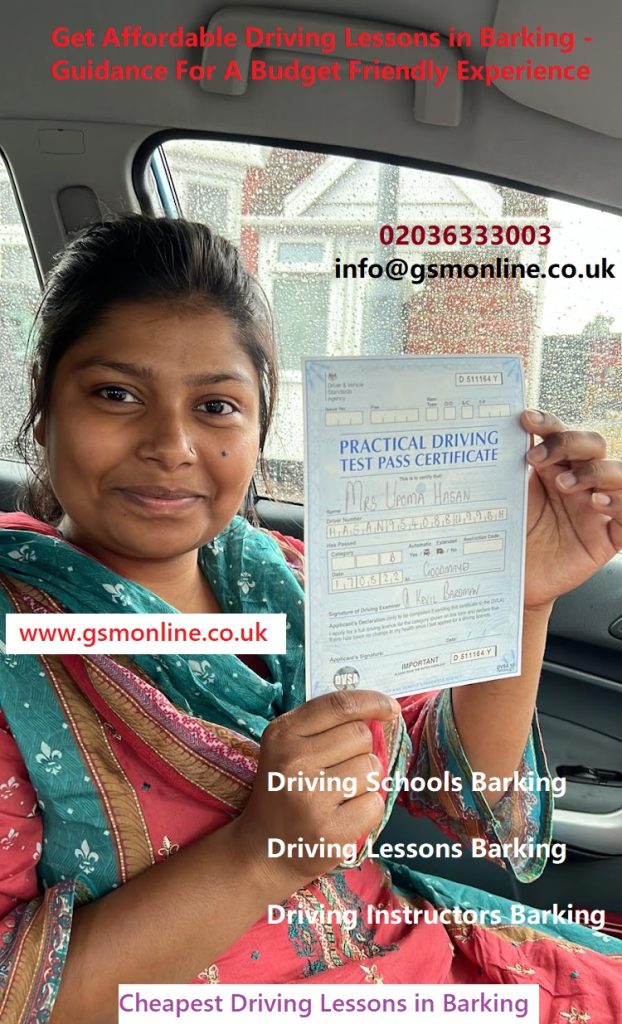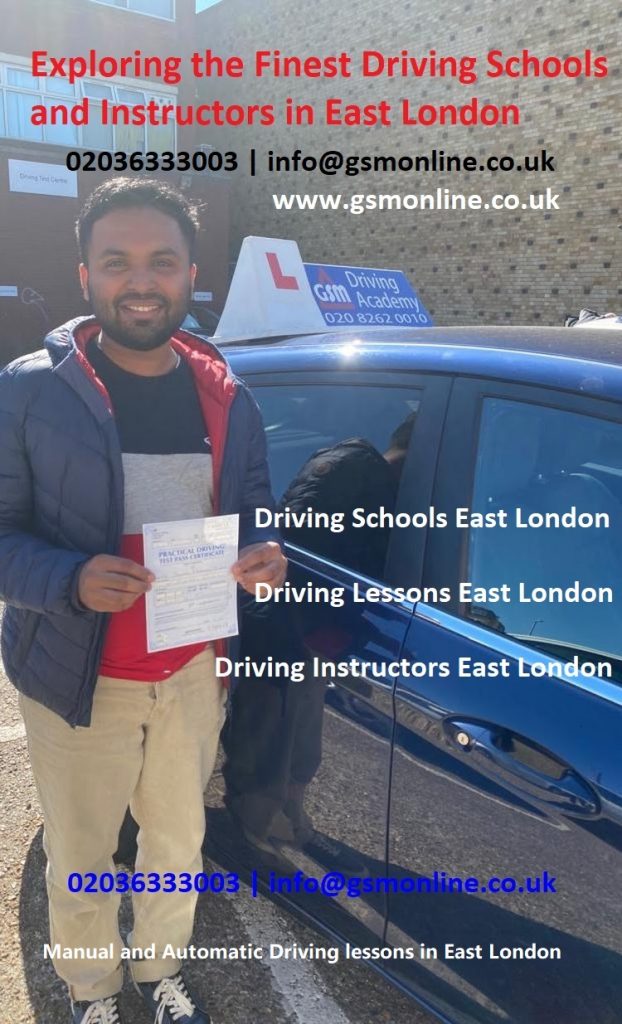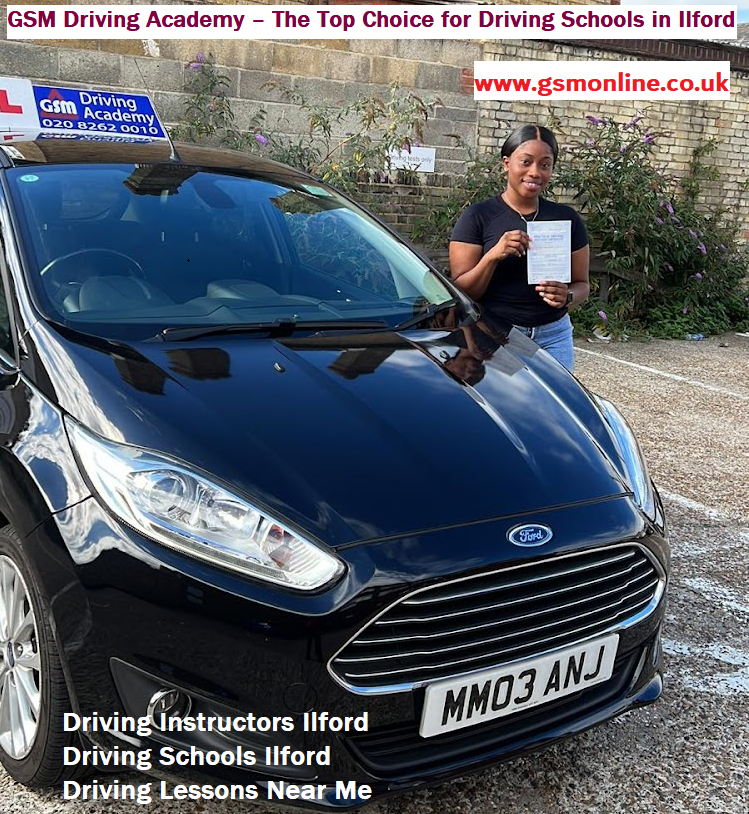At some point in life, everyone needs to learn how to drive, and getting your license can be a difficult task. When it comes to finding a driving instructor in Dagenham, you want to make sure you’re choosing an experienced and qualified instructor who can give you the best guidance and instruction. In this blog post, we’ll discuss what to look for and what to expect from experienced driving instructors in Dagenham. We’ll go over the types of lessons.
- Driving Lessons Dagenham
- Manual Driving Lessons Dagenham
- Automatic Driving Lessons Dagenham
- Pass Plus Driving Courses Dagenham
- Intensive Driving Lessons Dagenham
- Female Automatic Driving Lessons Dagenham
- Female Driving Instructor Dagenham
- Refresher Driving Lessons Dagenham
- Car Hire for Driving Test Day
- Cheap Driving Lessons in Dagenham
- Motorway Driving Lessons Dagenham
- Driving Instructors in Dagenham
Introduction to Driving Instructors in Dagenham
Are you looking for a driving instructor in Dagenham who can provide you with the best possible teaching experience while you learn to drive? At “What to Expect from Experienced Driving Instructors,” we understand how important it is to find the right driving school and instructors that can help prepare students for their driver’s license. We’ve created this comprehensive guide to present our readers with an introduction to the different types of driving lessons provided by local driving instructors in Dagenham, including intensive courses, automatic classes, beginner education programs, and much more.
Whether your goal is to learn how to drive at a basic or advanced level, finding an experienced and qualified instructor should be one of your primary concerns—after all, having trust in someone teaching you such an important skill is essential. With this article, we hope to highlight some of the most dependable and trusted schools in Dagenham, so that whether you’re just getting started on the roads or need specialized training for Pass Plus certification, there’s something for everyone.

Aside from experienced instructors who provide both manual and automatic learning paths, every quality coach must be up to date on all traffic laws and offer reasonably priced packages based on the type and duration of course that best suits, of course, individual needs. Most importantly, higher standards such as patience and adaptability should always be prioritized. We prioritise any tutoring services provided in Dagenham, regardless of whether they are provided by self-owned or externally owned vehicles.
At “What to Expect from Experienced Driving Instructors in Dagenham,” we understand cost issues can border around affordability rates but shouldn’t mean sacrificing quality, meaning whatever tuition tips are given to the person behind the wheel must never be forgotten because they ultimately can determine how successful the path towards full licensure becomes. That’s why our mission focuses mainly on providing budget-friendly prices without compromising the expertise each customer receives from certified trainers stationed within city limits, allowing aspiring motorists to access the same resources that those residing within wealthier counties in the surrounding area capitalize upon regularly.
If you would like to find out more about our Driving Lessons, please contact us on 020 3633 3003 or email info@gsmonline.co.uk
So, whether it’s getting free quotes before deciding on the exact length of terms required, then taking the Pass Plus course and ensuring a lifelong investment “pays dividends” (so to speak in the long run), then hopefully our overview of driving instructors based within zone postcodes will provide peace of mind and the attention needed to help busy London boroughs achieve their lifetime ambition of becoming fully qualified drivers.
Different Types of Driving Lessons are Available in Dagenham.
Are you looking for comprehensive driving lessons in Dagenham? With Driving Instructors Dagenham, you will find an experienced and reliable instructor to help you learn the art of safe driving. Our instructors provide a range of courses, such as intensive driving courses and automatic driving lessons, so that drivers of all levels can gain confidence and develop their skills on the roads, as part of our commitment to providing excellent driver training in Dagenham. We offer affordable packages that make learning to drive more accessible for everyone who wants it. These services are designed to get results quickly and easily for learners of all backgrounds, including those taking Pass Plus courses or beginning-level driver training. If you’re looking for a trusted driving school in Dagenham, then look no further than us.
We have a highly trained team dedicated to providing the best tuition, with expert guidance at every step, so that each student leaves the classroom better equipped at the end of their course or lesson. Whether you’re a seasoned driver or are just getting started, we’ve got automatic driving instructors ready and waiting for you. Learn how operating an automatic gearbox correctly makes maneuvering easier while getting comfortable with clutch control without any hassle.
Dagenham Driving Lesson Cost
Driving Instructor Dagenham provides low-cost driving lessons near me in the greater London area and beyond, allowing you to begin learning to drive without spending a fortune.
Intensive Driving Lessons in Dagenham
Are you looking for an intensive driving course in Dagenham or a trusted driving school with experienced instructors? Look no further. We have the perfect comprehensive guide to help you find the best driving lessons, whether you’re a beginner or looking to pass your plus test. With our extensive list of dependable and reliable automatic driving instructors, learning to drive in Dagenham couldn’t be any easier.
If you are looking for a driving instructor in Dagenham, we can help! We have been approved by the DVSA and are able to provide you with a qualified driving instructor who will teach you how to drive safely.
With years of experience as a leading provider of affordable and professional services, we understand how important it is to choose the right instructor when taking your first lesson. Our qualified staff is dedicated to helping you get the most out of your new journey and will provide quality instruction tailored specifically towards achieving success. Additionally, all our instructors are CRB-checked so that safety comes first, providing peace-of-mind while also ensuring the best value during each lesson.
If you’re considering intensive driving lessons in Dagenham, then look no further than us. We make sure that these courses are conducted at times suitable for your needs and that everything is done properly with approved procedures by local authorities, leaving nothing unanswered or unaccounted for before taking on the roads legally without supervision. You can start receiving tuition either from home or anywhere else convenient around Dagenham using both manual and automatic cars depending on your own personal preference, allowing maximum benefits with minimal time wasted travelling between locations throughout December and January to help encourage beginner drivers even more upon completion of their study period.
We also offer exclusive Pass Plus Courses across several districts, which include putting together many hours of behind-the-wheel practice in tricky scenarios such as rural roads, along with night drives under controlled conditions, guaranteeing a sufficient skill level once arriving at valid test centers located within miles of us here at Driving Instructors Dagenham. Furthermore, learner drivers of any age can attend these specialised classes, implying that anyone over the age of can begin training immediately while building full confidence over weeks or months until they are safe enough to tackle road laws actively on their own after passing theory tests beforehand (where applicable).
Customers should never feel as if they are paying extortionately high fees due to the support vehicles being well maintained and exacting standards being strictly adhered to by licensed experts willing to assist everybody save money along the way without compromising quality in any way. Naturally, there is always the option to compare firms, but finding a highly recommended one in proximity, such as ours, makes the entire process much less stressful, especially when certain discounts are applied on occasion.
Automatic Driving Lessons in Dagenham
Looking for the best automatic driving lessons in Dagenham? Then you have come to the right place. This blog post will provide a comprehensive guide on all things related to driving lessons and courses in Dagenham. Here, we’ll explore the various options available, including driving instructors, intensive driving lessons, affordable driving lessons, and much more.
Beginners often find learning to drive daunting, but with the right instructors and materials, it can be made easier. Finding an experienced automatic driving instructor in Dagenham is essential when taking your first steps behind the wheel of a car. They’ll provide guidance while teaching defensive driving techniques. With an automatic driving instructor, you don’t have to worry about stalling or jerking, as there won’t be any manual controls that need to be operated by hand.
Pass Plus courses in Dagenham are another excellent option for drivers of all levels. These courses are designed to give new or inexperienced drivers extra confidence when driving on roads with other vehicles or hazards such as traffic lights and roundabouts. Experienced driver trainers can help teach learners how to handle difficult situations that may arise while helping them build their skill set for safe driving habits long after passing their test.
Driver Training School courses from the beginner level through advanced are also offered at competing schools throughout Dagenham, meaning there is something tailored to everyone’s needs no matter what your prior knowledge may be like. Furthermore, these schools offer flexible time slots specifically designed around student convenience so that regardless of whether working professionals intend on receiving instruction during peak hours (school clubs, etc.), they will always find suitable time slots easily accessible near them.
Lastly, looking up “Driving Lesson Cost” nearby should return reliable results regarding which provider offers affordable services within your desired locality; this ensures that price remains competitive without compromising quality standards set by qualified instructors certified by local governmental association bodies relating to transport training operations approved within licensed professional networking associations such as ADI (Approved Status) and DVSA (Licensing).
Pass-Plus Courses in Dagenham
Are you looking for a driving school in Dagenham? Look no further than “What to Expect from Experienced Driving Instructors in Dagenham“— A Comprehensive Guide Our team of experienced and qualified driving instructors provides expert support to help you learn the basics of driving. We offer automatic, intensive, and pass-plus courses, as well as beginner driver training programs tailored especially for first-time drivers. Plus, our affordable rates mean that learning to drive doesn’t have to be out of reach.
At “What to Expect from Experienced Driving Instructors in Dagenham“: A Comprehensive Guide, we understand that every student needs different levels of assistance when it comes to learning how to drive. With this in mind, we offer both manual and automatic driving lessons so students can choose what suits them best for their own learning style and comfort level. We also cater to those who are more experienced by offering intensive courses that are designed with busy schedules in mind. And don’t forget about our Pass Plus courses, which allow drivers from all backgrounds to improve their skill set on the roads safely—everything needed to become an independent road user.
When searching for reliable driving instructors, Dagenham locals can rest assured knowing they will receive top-quality tuition from an approved institution. “What to Expect from Experienced Driving Instructors in Dagenham“—A Comprehensive Guide Not only do we provide comprehensive lessons with helpful tips, but our instructors go above and beyond by teaching safe habits too—something no professional driver would be without. Furthermore, all students will benefit from regular feedback reports that help track progress along their course, ensuring they stay on track to successfully complete qualifications like. The Pass Plus Course or Mastering Beginner Driver Training Fundamentals.
Unlike other schools around town, we ensure each student receives individual attention so they get the absolute most out of our programs—giving them greater confidence while behind the wheel is something that cannot be overlooked when it comes down to safety assumptions. So the ability to save money while still receiving premium instruction sets us apart from other services vying for your attention—something hard-earned after years of providing trusted service across London boroughs thanks to satisfied customers spreading word-of-mouth referrals far and wide. Making sure that everyone, regardless of income, has access to a great education explains why people have returned for the past two decades and counting.
The best option for those looking for Driving Lessons Cost Near Me is What to Expect from Experienced Driving Instructors in Dagenham: A Comprehensive Guide. Nobody works harder in the city to ensure that residents receive excellent teaching and learning skills for their driver’s license. Daggenahm is done automatically by friendly automatic teachers who are passionate about making city streets safer. Most importantly, everyone has a happy thought process knowing that the aforementioned costs were precisely paid up front, which respects affordability as it pertains to short- and long-term financial situations more frequently, thus entrusting us to deliver desired results under any circumstances imaginable, which is why true leaders in the industry do so proudly.
Beginner Driver Training in Dagenham
Learning to drive can be an intimidating process, especially if you’re a beginner. With the right lessons and training, however, you can get started on the path towards becoming a safe and confident driver in no time at all. If you live near Dagenham, then finding an experienced driving instructor with good reviews is important—look no further than Driving Instructors Dagenham. They offer beginner drivers comprehensive on-road tuition in both manual and automatic cars, as well as special packages like intensive driving courses and pass-plus courses designed to help build confidence even faster.
Are you looking for quality driving lessons in Dagenham? Our expert driving instructors know Dagenham inside and out. Book online and start learning!
Whether you’re already a competent driver or just starting out for the first time, Automatic Driving Lessons Dagenham has got your back. Their team of qualified instructors is patient and supportive of learners from all backgrounds, making sure that everyone gets the best instruction possible at highly affordable rates. Booking online is easy— simply select the time that suits you best for either manual or automatic driving lessons, along with any additional services such as Pass Plus or Intensive Courses.
Looking for something cheaper? There are many low-cost driving lessons available from reputable providers such as Learning To Drive In Dagenham, who offer excellent value instruction so that anyone can benefit from excellent instruction while staying within their budget. What’s more, they also offer different discounts depending on how many hours you book at once— perfect if your goal is to become proficient quickly without breaking the bank.
Want more control over when and where your lessons take place? Try looking into one of several great driving schools in Dagenham that allow customers to create their own timetable and have access to pick-up points across much of the Greater London area, so learning takes minimum effort but maximum results remain assured. All of this, combined with friendly tutors who strive to make each lesson enjoyable while teaching important traffic regulations, means that getting road-ready has never been easier or less expensive, which is ideal if price is a concern but quality is not.
Contact Trusted Driving School in Dagenham today to learn more about available options, including flexible payment plans tailored around individual customers’ needs, ensuring everyone gets top-level service regardless of spending limitations, and meaning costs should never be a barrier stopping people from achieving their dreams of having a license in the safest way possible.
What to Expect from Experienced Driving Instructors in Dagenham
Are you selecting the right driving school in Dagenham? Looking for a trusted instructor to help you gain your license and become confident on the road? Here’s what to expect from experienced driving instructors in Dagenham: From intensive driving lessons to automatic driving lessons, they have it covered. Whether you are a beginner or an experienced driver, they can provide quality tuition at affordable rates, making sure that each student is successful in their journey of gaining independence on the roads.
Driving instructors at reputable schools, such as Driving Schools Dagenham, will offer students tailored instruction at all levels. Pass Plus courses are also available, which include six modules covering motorways, nighttime, and rural road experiences—perfect for those who want advanced-level training beyond the general requirements. Beginner drivers can get specialised driving programs alongside one-on-one sessions with qualified instructors, giving first-timers more confidence behind the wheel.
There is something suitable for everyone depending on their specific needs, whether it’s manual or automatic car hire, short-term deals, or long-term packages; it could be learning how to park correctly or improving speed awareness safety techniques, which will save money if encountered by police fines. Even cheaper options such as block booking sessions provide great value without compromising any sort of satisfaction from these well-established instructors teaching around East London boroughs like Barking and Romford; so whether you are searching for “driving lessons near me” rest assured our team breaks down road boundaries when bringing services close to home.
Professionalism should always be a top priority when looking for a “trusted” driving school in Dagenham, allowing greater peace of mind knowing its certified members will confirm key promises throughout your journey towards obtaining your license, including courtesy and costs, while adhering to punctuality and ensuring both parties acquire promised results before final payments are made.
Call 020 3633 3003 To Book Your Driving Lessons Change Your Life, Learn to Drive in Barking and Dagenham.
So why not take advantage of this opportunity right now by inquiring about our regular prices and offers in nearby segments such as Driving Lessons Cost in Dagenham and Automatic Driving Instructors in Dagenham? Your nearest available instructor, armed and equipped and possessing a full understanding of support positions, may be only a phone call away, allowing you to maybe unwittingly pass initial tests by leveraging combined expertise either here online, via social networks, or by booking clinics; alternatively, contact local offices and introduce the latest methods proven successful year after year.
At the end of the day, experienced driving instructors in Dagenham are essential if you want to learn how to safely drive. They provide a range of services, including beginner driver training, intensive driving lessons, automatic driving lessons, pass-plus courses, and more. With their guidance and lessons, you will be able to become a confident driver and possibly pass your driving test with flying colors.







